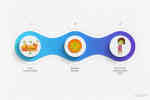Step 1 of 3•7 minutes read
Food Poisoning and Control
Below are your keywords for this section of your training. These words you will use during your work and will appear in the final exam, so be sure you learn them.

Keywords

The Incubation period of food poisoning is usually 1- 36 hrs.
Food poisoning, also called foodborne illness, is an illness caused by eating contaminated food. Infectious organisms — including bacteria, viruses and parasites — or their toxins are the most common causes of food poisoning. Below are a few examples.
You do not need to know all of the below for your exam but it is very useful to know as part of your job role. Knowing symptoms will help the team understand the possible source if any illness presents itself.
The symptoms of food poisoning are listed below. The Incubation period of food poisoning is usually 1- 36 hrs. This means the time a person is infected but yet to show symptoms. The common duration of food poisoning is 1 - 7 days, this means how long the person is infected. anyone suffering from symptoms of food poisoning must not return to the food preparation environment until 48 hours after symptoms have disappeared.
- Stomach Cramps,
- Diarrhoea,
- Vomiting,
- Nausea/feeling sick,
- Fever,
- Dehydration, and
- Collapse.
Salmonella:
The onset period is 1-7 hours (usually 2-4 hrs) and symptoms include vomiting, nausea, abdominal pain, diarrhoea and occasionally fever and collapse.
- Salmonella infection (salmonellosis) is a common bacterial disease that affects the intestinal tract.
- Salmonella bacteria typically live in animal and human intestines and are shed through faeces.
- Humans become infected most frequently through contaminated water or food.
Bacillus Cereus: This is a spore-forming bacteria
The onset period is 1-5 hours and causes vomiting, nausea, abdominal pain, and diarrhoea.
- Rice, potatoes, peas, beans and spices are common sources of B. cereus.
- The presence of B. cereus in processed foods results from contamination of raw materials.
- The resistance phase of spores to heat and other manufacturing processes was discussed in the previous steps.
Clostridium Perfringes: This is a Spore-Forming Bacteria
The onset period is 2 hours to 8 days and symptoms include abdominal pain and diarrhoea. Vomiting is rare.
- Clostridium perfringens bacteria are one of the most common causes of foodborne illness (food poisoning).
- C. perfringens can be found on raw meat and poultry, in the intestines of animals, and in the environment.
- C. perfringens spores sometimes survive cooking; they can germinate and multiply, resulting in large numbers of bacteria when cooked meat that is contaminated with C. perfringens is left at room temperature or even up to 60° C for a period of time.
Clostridium Botulinum: This is a Spore-Forming Bacteria
The onset period is 2 hours to 8 days (usually 12-36 hrs) and symptoms include vomiting, nausea, abdominal pain, diarrhoea and fever causing difficulties in swallowing and breathing.
- Soil, vegetables, and the intestinal tract of fish and mammals.
- Multiplies between 3.3°C and 50°C under anaerobic conditions.
- Sources are low acid processed food, vacuum-packed meat or fish, smoked fish, products containing spices, garlic, oil, mascarpone cheese and dried milk.
Staphylococcus Aureus:
The onset period is 1-7 hours and symptoms include vomiting, nausea, abdominal pain, diarrhoea and fever.
- Found in the skin, hair, noses, and throats of many people and animals. Up to 25% of healthy people have this bacteria and it can easily be transmitted into food.
- It's most often spread by someone who has the bacteria and did not wash their hands properly. Meal preparation is a common way staphylococcus is spread. Someone with an infection and unclean hands can handle food or the equipment used to prepare it which may be the cause of the bacteria spreading.
Norovirus:
The virus is in the vomit of ill persons and spread by airborne infection, environmental contamination and from person to person. It is very infectious with an onset period of 10-50 hrs causing vomiting, nausea, abdominal pain, diarrhoea and fever. The infective dose is very low.
E-coli:
This is found in the intestine of humans and animals where it is generally harmless. However, E-coli produced toxins that can be deadly in young children and the elderly. The onset period is 1-7 hours and causes vomiting, nausea, abdominal pain, and diarrhoea (often with bright red blood) but without fever. The incubation period is 1-8 days. Spread is through person-to-person contact and direct contact with animals.
Typhoid:
Is caused by the bacteria salmonella typhi with an incubation period of 8-14 days. Symptoms include fever, malaise, slow pulse, spleen enlargement, rose spots on the trunk, constipation and sometimes diarrhoea.
Campylobacter:
This is now the frequently reported reason for bacterial diarrhoea in the UK. Symptoms include headache, fever, and diarrhoea but vomiting is rare with an onset period of 1-7days. Sources include raw milk, sewage, and offal.
Listeria:
Excreted by human or animal carriers and causes flu-like symptoms. At-risk groups should avoid soft cheeses, cook-chill meals and pates.

Common Food sources for Food Poisoning
- Undercooked poultry and meat as the food already is contaminated and not cooked thoroughly to kill the bacteria.
- Desserts often have raw eggs in them like mousse. They are also high risk if they are not covered and stored correctly.
- Fish/shellfish are sometimes eaten raw. They can cause a viral issue if they have grown in waters that are contaminated by sewage. This means any viruses in the humans or animals that created the sewage will be in the fish/shellfish.
- Cooked meats are high in protein and support the multiplication of bacteria if not stored correctly. These are high-risk foods.
- Salads fruits and vegetables can contain viruses from contaminated water used when growing. Therefore they must be washed properly. This will also remove any chemical fertilisers that can cause food poisoning as well.
- Milk/milk products if raw unpasteurised milk is used.
- Eggs/egg products if the dish is not cooked. Another example other than dessert is fresh mayonnaise.
Some people are more like to suffer from poisoning as they are more vulnerable to illness. These vulnerable people may include but not be limited to:
- The Elderly,
- Babies and younger children,
- People who are already sick, and
- Immunocompromised (having a weakened immune system) for example people recovering from treatments like chemotherapy.
Food poisoning rarely occurs because of a single isolated mistake. Food poisoning results from management failing to identify hazards and/or failing to control these hazards.

Breaking the chain above:
- STOP the contamination of high-risk food.
- PREVENT the multiplication of bacteria within the food. Remember bacteria need food, warmth, time and temperature to survive and multiply.
- REDUCE the risk of contaminated food being eaten by following good food safety procedures.
Some pathogenic bacteria organisms may also be transmitted by ways other than food, for example, person-to-person spread or contact with animals. Examples are E-Coli, Norovirus, Dysentery, Hepatitis, Listeria, Typhoid, Campylobacter Enteritis, and Parasites. These bacteria are found in the faeces of infected humans and animals.
They are low-dose pathogens in the main and when transmitted via food, the faecal-oral route is common. A low dose means that only a small number can make you sick.
As you can see from the picture below it is really not that pleasant at all!!
Pathogens → faeces → hands → food → eaten

Pathogens → faeces → hands → food → eaten